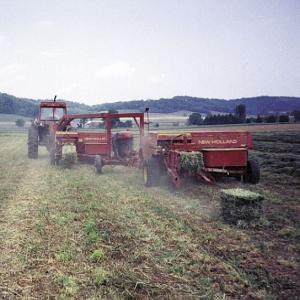1998 - Volume #22, Issue #4, Page #20
[ Sample Stories From This Issue | List of All Stories In This Issue | Print this story
| Read this issue]
Farmer-Built Hitch Pulls Two Balers At Once
 |
 |
The Stahls already owned the two balers. The bridge hitch goes up and over the first baler to a two-wheel engine platform - fashioned from the rear axle and wheels off an old Massey combine - that's positioned ahead of the second baler. A 40 hp Continental gas engine direct-drives the rear-baler pto. The front baler is powered by the tractor pto.
The rear engine is controlled from the cab. Wiring runs through the hitch. An electric window motor controls the engine's throttle. A tachometer and shut-off switch mount in the cab. The Stahls apply preservatives to their hay when needed. Controls for applying preservative at the second baler are also in the cab.
The axle at the back of the hitch is designed to run at a slight angle. The engine hydraulically pivots to stay in line with the baler's pto shaft when turning at the end of the field. The engine rides on a steel platform that is free to swivel on a pair of heavy wall pipes that ride inside two other pipes. The platform is connected to a tie rod on the axle and is pushed or pulled by a hydraulic cylinder - the same cylinder that originally controlled the steering wheels on the combine.
"We've made about 500 tons of hay with it for the last three years with no problems," says Stahl. "On a good day we can put up 3,400 60-lb. bales. We built it because we figured it was cheaper to build the hitch than it was to hire someone to operate a second baler. We spent about $5,000 to build it. About $4,000 of that was for the engine which we bought new. The rest was for steel. A round baler might have cost less. However, most of our hay goes to horse owners in Virginia and Maryland who want premium quality, small bales.
"The bales are not modified in any way so if we want we can unhook from the hitch and run the machines conventionally.
"The distance between the front of the tractor and the bale chute on the rear baler is 60 ft. We find that it does require some skill to operate two balers at once. Fortunately we have nice level fields and plenty of room to turn. We drop the bales on the ground and pick them up later with a self-propelled automatic bale wagon."
The hitch is hooked to a homemade fifth wheel hitch that replaces the tractor's 3-pt. hitch. The operator hydraulically swings the second baler right behind the first one for transport.
Contact: FARM SHOW Followup, William D. Stahl, RR 1, Box 285, Loysville, Pa. 17047 (ph 717 789-3244).

Click here to download page story appeared in.

Click here to read entire issue
To read the rest of this story, download this issue below or click here to register with your account number.




